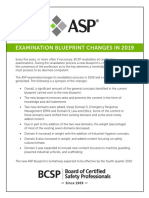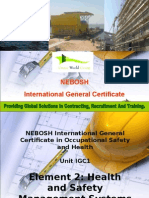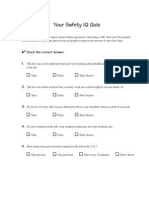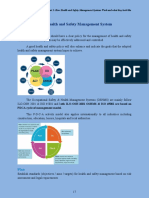Igc 1 Element 7
Igc 1 Element 7
Uploaded by
Emmanuel ClarosCopyright:
Available Formats
Igc 1 Element 7
Igc 1 Element 7
Uploaded by
Emmanuel ClarosOriginal Title
Copyright
Available Formats
Share this document
Did you find this document useful?
Is this content inappropriate?
Copyright:
Available Formats
Igc 1 Element 7
Igc 1 Element 7
Uploaded by
Emmanuel ClarosCopyright:
Available Formats
ELEMENT 7 IGC-1 Monitoring, Review and Audit Outline and differentiate between active monitoring procedures and reactive
monitoring procedure? Or Define active and reactive monitoring? Active Monitoring: Is about checking to ensure that standards are meets and that the workplace is in fact safe and free of health risk before any unpleasant event takes place. There are four active monitoring methods can be use to check conformance to standards -Safety inspection -Sampling -Tours -Surveys Safety inspection: The term safety inspection can be applied to: Routing inspection, statutory inspection, periodic inspection and pre use inspection Sampling: For example in large office which have 1200 fire extinguishers must be inspected by competent engineer then there are several ways to check 1.to check the inspection record to ensure all FE are signed 2.check all 1200 FE directly one by one 3.check 50 FE randomly from 1200 FE Item no 3 is sampling Safety Tours: A safety tour is high profile inspection of a workplace carried out by a group of managers Safety Survey: Safety survey of one particular issue or topic What do you mean by systematic monitoring? Systematic inspections: One way to actively monitor health and safety performance is to carry out systematic inspections. These inspections can focus on the four Ps: 1.Plant: machinery and vehicle and examinations 2.Premises: the workplace and the working environment 3.People: working methods and behavior
4.Procedures: safe system of work, method statements and permit to work etc. State the sources of information used in reactive monitoring? Reactive Monitoring Reactive monitoring is about measuring safety performance by reference to accidents, incidents and ill health that has already occurred. Reactive monitoring uses accidents, incidents, ill health, and other unwanted events and situations as indicators of health and safety performance.We can calculate Accident Incident Rate (AIR) by this formula AIR = , number of accident during a specific time period . X 1000Average numbers of workers over the same time period State the purpose of workplace inspections? Arrangements for workplace inspections: Workplace inspection plays an important role in ensuring that safety standards are acceptable in the workplace. Various factors must be considered when setting up an inspection system such as: 1.the type of inspection 2.the frequency of inspection 3.the responsibilities for inspection 4.the competence of the inspector 5.the use of checklists 6.action planning for problem found What should the introductory part of an inspection report contain? Or Considered how to write an effective inspection report? Effective report writing: Many inspection systems require the inspector to write a report summarizing their main finding and recommendations. If an inspection report is written then it must be effective. This requires an appropriate: -Writing style -Structure -Contend -Justify recommendations Explain the purpose of regular reviews of health and safety performance? Review of Health and Safety Performance: Reviewing health and safety performance should be done by managers at all level within the organization on a routine basis to ensure that management system are working effectively.
Gathering information: Reviewing performance relies on data gathered from various sources such as: 1.Accident data 2.Inspections 3.Absence and sickness data 4.Safety surveys, tours and sampling 5.Audit reports 6.Other sources (e.g. complaint form workers or QA reports) Reporting on performance: Safety specialists usually play a key role in collecting this data and reporting on performance to senior management. What role does senior management have in workplace inspections? Role of senior management: After getting reports form safety specialists then senior management have to role in evaluating this information so that appropriate priorities and resources can be allocated. Continues improvement: Review enables action to be taken so that health and safety performance is continuously improved. Explain the meaning of term health and safety audit and describe the preparations that may need prior, during and after audit? Or Define health and safety auditing? Auditing: Auditing is the systematic, objective, critical evaluation of an organizations health and safety management system Purpose of auditing: Auditing is mechanism for verify that an organizations safety management is in place and operating effectively. It will check that 1.Appropriate management arrangement is in place. 2.Adequate risk control systems exist. 3.Appropriate workplace precautions are in place The audit process: What follows in a fairly typical audit process? -Pre audit preparations -During the audit -At the end of audit Pre audit preparation: Before the audit starts the following should be defined:
-The scope of the audit (will it cover HSE management as well) -The area of the audit (on department or whole department) -The extend of the audit (comprehensive or selective) -Who will be required (who will accompanied from contractor side) During audit: During audit three different types of evidence will be sought: 1.Documents and records 2.Interviews 3.Direct observations in the workplace. The typical information examined during audit: 1.Health safety policy 2.Risk assessments 3.Training records 4.Safety MOMs 5.Maintenance records 6.Accident investigation reports 7.Emergency arrangements 8.Inspection reports At the end of the audit: Verbal feedback is usually provided at the end of audit and then written reports will be followed after.Internal & external Audit. audit are done by internal manager and external audits are done by third parties
You might also like
- Iosh Risk Assessment Project v20 PDFDocument2 pagesIosh Risk Assessment Project v20 PDFRajendra0% (1)
- GC1 Element 2Document7 pagesGC1 Element 2Wafula RobertNo ratings yet
- Hse ManualDocument10 pagesHse ManualJkNo ratings yet
- Understanding The Principles and Practices of Assessment: D/601/5313 VRQ UV30563Document20 pagesUnderstanding The Principles and Practices of Assessment: D/601/5313 VRQ UV30563حيدرالركابي100% (1)
- Architecture of SafetyDocument7 pagesArchitecture of SafetyArmando PalmaNo ratings yet
- Microsoft PowerPoint - IG1 Element 3 PDFDocument36 pagesMicrosoft PowerPoint - IG1 Element 3 PDFsaad100% (2)
- Igc1 5Document14 pagesIgc1 5Amir SohailNo ratings yet
- FY06 46c6-Ht21 English B 7 Hand Power ToolsDocument35 pagesFY06 46c6-Ht21 English B 7 Hand Power Toolstu100% (1)
- IG1 Element 3Document107 pagesIG1 Element 3Mohammed Alawod100% (1)
- Cat Gen Cut & Bend JUNE 2017Document40 pagesCat Gen Cut & Bend JUNE 2017Jasmin RedzepagicNo ratings yet
- Nebosh National Certificate in Construction Safety and HealthDocument5 pagesNebosh National Certificate in Construction Safety and Healthshahzad444100% (1)
- Al Delma PPT Oil &gas Day 4Document75 pagesAl Delma PPT Oil &gas Day 4Rasha AlzubaidiNo ratings yet
- Advanced Risk Assessment Course FlyerDocument4 pagesAdvanced Risk Assessment Course FlyerMohamed AdamNo ratings yet
- Inherently Safer and More UserDocument8 pagesInherently Safer and More UseralijadoonNo ratings yet
- IGC1 Element 2 New SyllabusDocument28 pagesIGC1 Element 2 New SyllabusMujawir HussainNo ratings yet
- Igc 1.5 PDFDocument7 pagesIgc 1.5 PDFclementNo ratings yet
- ETG3 - Guidelines For Safety Audit ReportsDocument5 pagesETG3 - Guidelines For Safety Audit ReportsRahul RamachandranNo ratings yet
- 001-A Comparative Analysis of Process Safety Management (PSM) Systems in The Process IndustryDocument14 pages001-A Comparative Analysis of Process Safety Management (PSM) Systems in The Process IndustryMiningSafety185No ratings yet
- SG Angle GrindersDocument2 pagesSG Angle GrindersAsad KhanNo ratings yet
- Work Place InspectionDocument24 pagesWork Place InspectionMayom MabuongNo ratings yet
- Course Outline - Scaffolding Safety Course-2 DayDocument2 pagesCourse Outline - Scaffolding Safety Course-2 Dayaliindian1No ratings yet
- ASP10 BlueprintDocument4 pagesASP10 Blueprintgeologistlakhan100% (1)
- Hazard Identification and AssessmentDocument11 pagesHazard Identification and AssessmentLizz NgagNo ratings yet
- CFI-I Exam DumpsDocument3 pagesCFI-I Exam DumpsdrnikolashesselNo ratings yet
- HSE Alert 105-21 Welder Finger InjuryDocument2 pagesHSE Alert 105-21 Welder Finger InjuryAlecs NedeaNo ratings yet
- IGC-3 Full AssessmentDocument13 pagesIGC-3 Full AssessmentMuhammad100% (1)
- Hazard Audit ReportDocument15 pagesHazard Audit ReportMuhammadIzharNo ratings yet
- Safety JournalDocument58 pagesSafety JournalmuraliNo ratings yet
- FahmiDocument96 pagesFahmiابو محمد عليNo ratings yet
- IGC1 Element 4 New SyllabusDocument106 pagesIGC1 Element 4 New SyllabusUMAR FAROOQ50% (2)
- Oshad-Sf General Paper NotesDocument8 pagesOshad-Sf General Paper NotesHussain AhmadNo ratings yet
- Nebosh International General Certificate: © GWG TrainingDocument34 pagesNebosh International General Certificate: © GWG TrainingAnis Badshah100% (1)
- Iosh Managing Safely Version 5Document1 pageIosh Managing Safely Version 5Tatweer Jhane AlemanNo ratings yet
- MsdsDocument5 pagesMsdsHalfianiNo ratings yet
- Find The HazardDocument40 pagesFind The HazardWilliam LuxNo ratings yet
- Genral Risk Assesment 15.8.2023Document57 pagesGenral Risk Assesment 15.8.2023sohaibNo ratings yet
- NEBOSH Construction Certificate: Unit Ncc1Document32 pagesNEBOSH Construction Certificate: Unit Ncc1francis100% (1)
- Ramp Safety CultureDocument11 pagesRamp Safety CultureRumesh ThilakarathnaNo ratings yet
- REd Hat Safety BrochureDocument3 pagesREd Hat Safety BrochureAmal JagadiNo ratings yet
- International Diploma Unit 3 Supplementary Guidance Sept 2017Document6 pagesInternational Diploma Unit 3 Supplementary Guidance Sept 2017raj KumarNo ratings yet
- Keypoint Element 2Document16 pagesKeypoint Element 2Mahbub KhanNo ratings yet
- Basic Behavior Based SafetyDocument7 pagesBasic Behavior Based Safetydroffilcz27No ratings yet
- Kumbirai Answer Madenyika UB10930SME17914: Safety EngineeringDocument11 pagesKumbirai Answer Madenyika UB10930SME17914: Safety EngineeringKumbirai Answer MadenyikaNo ratings yet
- IS 14489 Rev 2010Document36 pagesIS 14489 Rev 2010Himanshu KumarNo ratings yet
- NEBOSH IGC E-Learning PDFDocument2 pagesNEBOSH IGC E-Learning PDFZaki AdamouNo ratings yet
- Angle Grinder Hazard AwarenessDocument21 pagesAngle Grinder Hazard AwarenessMohammad Ashpak100% (1)
- EBook - Contractor Safety ManagementDocument7 pagesEBook - Contractor Safety Managementmondi123No ratings yet
- Safety-Officer Jib Decription OffshoreDocument3 pagesSafety-Officer Jib Decription OffshoremashanghNo ratings yet
- Lifting Equation For Manual LiftingDocument10 pagesLifting Equation For Manual LiftingShafiqul IslamNo ratings yet
- 2018 Feb 2018 Health and SafetyDocument9 pages2018 Feb 2018 Health and SafetyNabi BoxNo ratings yet
- IGC1 - Element 7 Monitoring, Review & Audit (1st Ed) v.1.0Document61 pagesIGC1 - Element 7 Monitoring, Review & Audit (1st Ed) v.1.0Umair Ahmed Abbasi75% (4)
- Chapter 3 - Safety and Health Strategy, Policy & CultureDocument25 pagesChapter 3 - Safety and Health Strategy, Policy & CultureEdgar LacsaNo ratings yet
- GC1 Element 2 29dec 2019 New Syllabus Draft - v5Document18 pagesGC1 Element 2 29dec 2019 New Syllabus Draft - v5Mohamed AslamNo ratings yet
- Sample IA GUIDEDocument7 pagesSample IA GUIDEAmalNo ratings yet
- SCBA Wiki PDFDocument6 pagesSCBA Wiki PDFomar benounaNo ratings yet
- Heavy EquipmentDocument3 pagesHeavy Equipmentテレブリコ ジェファーソンNo ratings yet
- Ergonomics in Welding ShopDocument6 pagesErgonomics in Welding ShopFikri RahimNo ratings yet
- Igc 1 Element 7Document4 pagesIgc 1 Element 7Emmanuel Claros100% (1)
- IGC 1 Element 8Document3 pagesIGC 1 Element 8Emmanuel ClarosNo ratings yet
- Igc 1 Element 5Document7 pagesIgc 1 Element 5Emmanuel ClarosNo ratings yet
- IGC 1 Element 6Document6 pagesIGC 1 Element 6Emmanuel ClarosNo ratings yet
- Igc 1 Element 2Document3 pagesIgc 1 Element 2Emmanuel ClarosNo ratings yet
- Igc 1 Element 5Document7 pagesIgc 1 Element 5Emmanuel ClarosNo ratings yet
- IGC 1 Element 1Document7 pagesIGC 1 Element 1Emmanuel ClarosNo ratings yet
- IGC 1 Element 8Document3 pagesIGC 1 Element 8Emmanuel ClarosNo ratings yet
- IGC 1 Element 1Document7 pagesIGC 1 Element 1Emmanuel ClarosNo ratings yet
- Igc 1 Element 2Document3 pagesIgc 1 Element 2Emmanuel ClarosNo ratings yet

































































